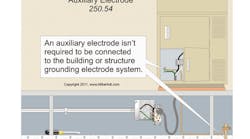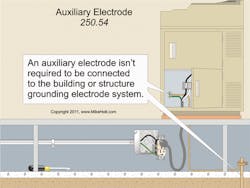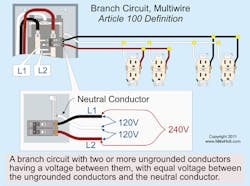Stumped by the Code? Grounding, Conduits, Overcurrent Protection & More
All questions and answers are based on the 2011 NEC.
Q. Can a ground rod alone be used to ground a light pole or other equipment instead of installing an equipment grounding conductor?
A. No. A ground rod to a light pole or other equipment is considered an auxiliary electrode by the Code and can’t take the place ofan equipment grounding conductor. Auxiliary electrodes can be connected to the circuit equipment grounding conductor. They’re not required to be bonded to the building or structure grounding electrode system, the grounding conductor to the electrode isn’t required to be sized to 250.66, and their contact resistance to the earth isn’t required to comply with the 25-ohm requirement of 250.53(A)(2) Ex [250.54], as shown in Fig. 1 (click here to see Fig. 1).
Caution: An auxiliary electrode typically serves no useful purpose, and in some cases it may actually cause equipment failures by providing a path for lightning to travel through electronic equipment.
The earth must not be used as the effective ground fault current path required by 250.4(A)(5).
Danger: Because the contact resistance of an electrode to the earth is so great, very little fault current returns to the power supply if the earth is the only fault current return path. What’s the result? The circuit overcurrent device won’t open and clear the ground fault, and all metal parts associated with the electrical installation, metal piping, and structural building steel will become and remain energized.
Q. Does the NEC require sizing conduit and conduit support racks large enough for future expansion?
A. No. The Code contains requirements considered necessary for a safe electrical installation. If an electrical installation is installed in compliance with the NEC, it will be essentially free from electrical hazards. The Code is a safety standard, not a design guide [90.1(B)].
NEC requirements aren’t intended to ensure the electrical installation will be efficient, convenient, adequate for good service, or suitable for future expansion. Specific items of concern, such as electrical energy management, maintenance, and power quality issues, aren’t within the scope of the Code.
The NEC doesn’t require electrical systems to be designed or installed to accommodate future loads. However, the electrical designer (typically an electrical engineer) is concerned with ensuring electrical safety (Code compliance) and also with ensuring the system meets customers’ needs — today and in the near future. To satisfy customers’ needs, electrical systems are often designed and installed above the minimum requirements contained in the NEC. Just remember, if you are taking an exam, licensing exams are based on your understanding of the minimum Code requirements.
Q. What size overcurrent protection is required on 14 AWG used for general branch circuit wiring?
A. 15A. Unless specifically permitted in 240.4(E) or (G), overcurrent protection must not exceed the following [240.4(D)]:
- 18 AWG copper — 7A
- 16 AWG copper — 10A
- 14 AWG copper — 15A
- 12 AWG aluminum/copper-clad aluminum — 15A
- 12 AWG copper — 20A
- 10 AWG aluminum/copper-clad aluminum — 25A
-
10 AWG copper — 30A
Q. What is the GFCI requirement for a receptacle behind a refrigerator in a dwelling family room that is less than 6 ft from the edge of a wet bar sink?
A. For other than kitchen sinks, GFCI protection is required for all 15A and 20A, 125V receptacles located within an arc measurement of 6 ft from the outside edge of the sink [210.8(A)(7)]. GFCI protection for the 15A and 20A, 125V receptacles specified in 210.8(A), (B), and (C) must be installed in a readily accessible location [210.8]. If the sink was located in the dwelling unit kitchen, GFCI protection wouldn’t be required [210.8(A)(6)]. 15A and 20A, 125V receptacles used behind refrigerators, under countertops for items such as for dishwashers, disposers, and trash compactors are often located within
6 ft from a kitchen sink. Because they don’t serve the countertops, GFCI protection isn’t required.
Q. Is there a minimum depth required for a junction box when conductors enter from the back of the box?
A. Yes. When insulated conductors 4 AWG or larger enter an enclosure in the wall opposite a removable cover, the distance from where the conductors enter to the removable cover must not be less than the bending distance as listed in Table 312.6(A) for one conductor per terminal [314.28(A)(2) Ex].
Q. What does the Code mean when it refers to a multiwire branch circuit?
A. A multiwire branch circuit is a branch circuit that consists of two or more ungrounded circuit conductors with a common neutralMultiwire branch circuits offer the advantage of fewer conductors in a raceway, smaller raceway sizing, and a reduction of material and labor costs. Multiwire branch circuits also can reduce circuit voltage drop by as much as 50%. However, because of the dangers associated with multiwire branch circuits, the NEC contains additional requirements to ensure a safe installation. See 210.4, 300.13(B), and 408.41 for details.
Q. What is the Code rule for disconnecting multiwire branch circuits?
A. Each multiwire branch circuit must have a means to simultaneously disconnect all ungrounded conductors at the point where the branch circuit originates [210.4(B)].
Note: Individual single-pole circuit breakers with handle ties identified for the purpose, or a breaker with a common internal trip, can be used for this application, see 240.15(B)(1).
Caution: This rule is intended to prevent people from working on energized circuits they thought were disconnected.
Holt is the owner of Mike Holt Enterprises, Inc., Leesburg, Fla. He can be reached at www.mikeholt.com.






